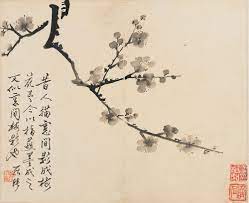Flower Power!

The Flower tiles in American Mahjong are essential tiles in many winning hands of the 2021 mahjong cards issued by the National Mah Jongg League. What is the power of the flowers in the cultural history of Mahjong?
In the Chinese version of the popular game, Flower tiles are not only beautiful, but also culturally meaningful.
It is common to see the Flower tiles in sets of four, as four plants or flowers, and as the seasons of the year. Depending on the Mahjong set, the flowers are commonly the Plum Blossom, Iris, Bamboo, and the Chrysanthemum.

These four flowers/plants represent the Four Confucian Gentlemen/women. The traditional term for “gentlemen” in Chinese, 君子 [junzi], originally referred mainly to men since education was generally restricted to men only in East Asian society. Historically speaking, there was no significant public education tradition in East Asia. Most school rooms were privately owned with private tutors. Some families taught their daughters as well as their sons to read, however, this was a small minority until more recent centuries where the Chinese term for “gentlemen” has taken on a more gender-neutral connotation. According to Confucian philosophy a gentleman/woman leads by example, and there is a role model for outstanding behavior associated with each season. It is taught that a true gentleman/woman does not influence a group by coercion or intimidation.
To lead by example, Confucius asks us to look to nature for the outstanding example in each season. In Winter in East Asia, when nearly no flower blooms, the Plum Blossom blooms. It blooms despite the harsh coldness and bleak winds. In Spring in East Asia, the Iris is the first flower to bloom. In the Fall, after all the other summer flowers wilt and die, the Chrysanthemum is the only bloom in full strength once the season turns colder.

Plum Blossom

Iris

Crysanthemum
With these three flower examples, none are opulent in appearance or pungent in fragrance. It is not the velvety rose, the stifling scented gardenia, nor the ruffled peony that is favored. Metaphorically, these three flowers-- the Plum Blossom, Iris, and Chrysanthemum—possess a singular stamina in the season without being overtly alluring. The message for the Confucian student is simplicity over lavishness; integrity over artifice.
In addition, the Bamboo represents the Summer Gentleman/woman. The Bamboo has many layers of meaning in Chinese/ East Asian culture. In the Confucian context, the Bamboo represents vitality, resilience, and flexibility. This plant with stolons, commonly called runners, grows very quickly. In a storm, it bends with the wind and bounces back. Metaphorically, the Bamboo is a tried and true gentleman/woman because it survives by resilience and flexibility, not by stubbornness.

Bamboo
On the Mahjong table, these flowers of the Confucian gentlemen/women remind us of good sportsmanship and gentlemanly/womanly behavior. These tiles tell us to enjoy the game without letting emotions such as the pain of losing or the joy of winning overpower our true nature. If one loses a third game straight, do not be tempted to childishly cast all the tiles off the table. If one wins the third time straight, do not gloat in the opponents’ losses. The beauty of the tiles is meant to bring out the best in the players.
We all win with the Flowers on our side. Good sportsmanship is the hidden power of the flowers.
-Yvonne Liu Wolf, Intercultural Consultant
About Yvonne:
Ms. Wolf is an intercultural consultant and founder of Chinese Intercultural, LLC, which offers business communication strategies, consultation and training services to business executives working with Chinese and East Asian partners. Further, cross cultural awareness and business etiquette training allow companies to operate more successfully with their businesses overseas.
In addition to business consulting, Yvonne speaks on a variety of topics that help to clarify elements of Chinese culture in an accessible and relatable context. Yvonne shares the knowledge and skills she has gained from her experiences living in four different countries where she became fluent in three languages (Chinese (Mandarin), English, and Danish). She worked as a bilingual analyst in a Japanese global corporation in Denmark and served as a global language trainer in Japan. She has also visited half the states in the USA. She has ten years' experience working as an organizational consultant in Los Angeles mediating cross cultural misunderstandings. She continues her work in the Greater Chicago area.
- Posted in:
- Mahjong History